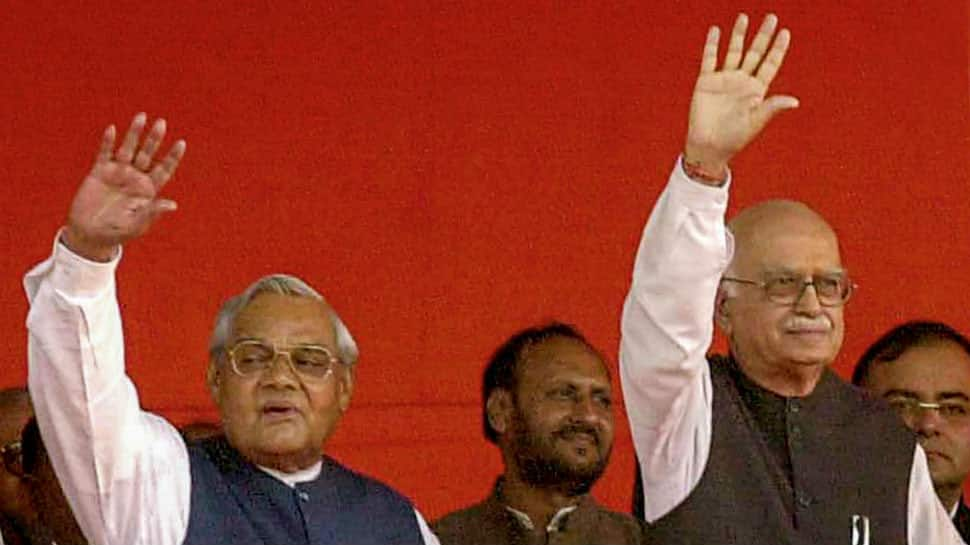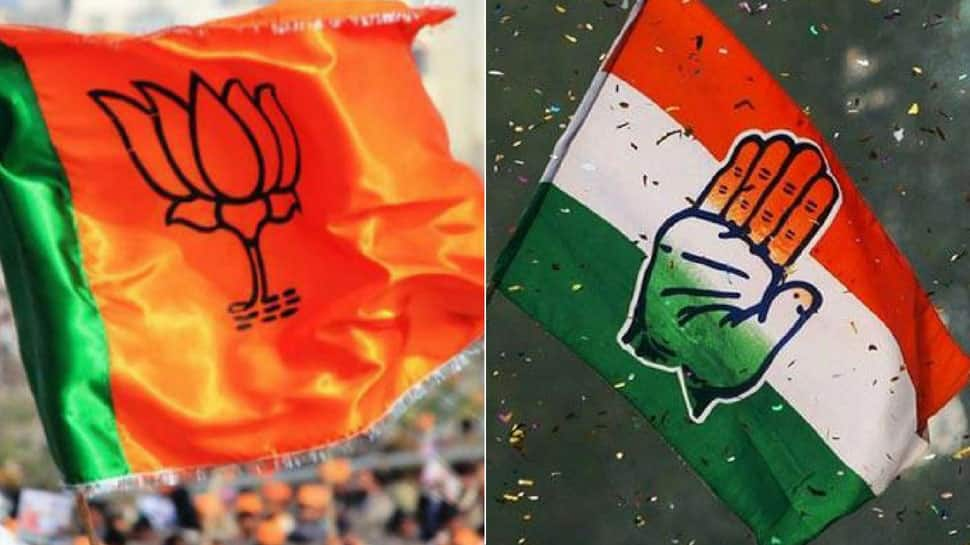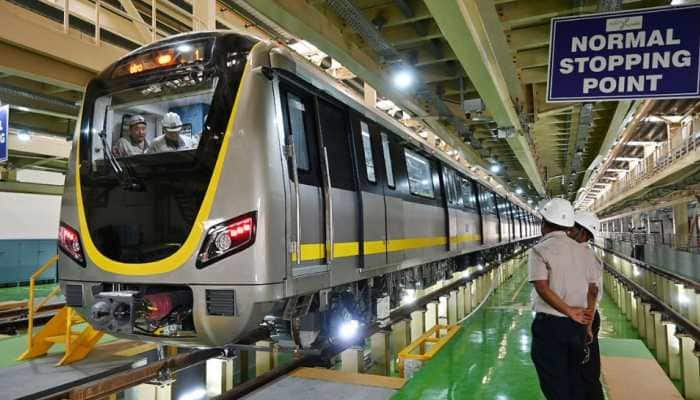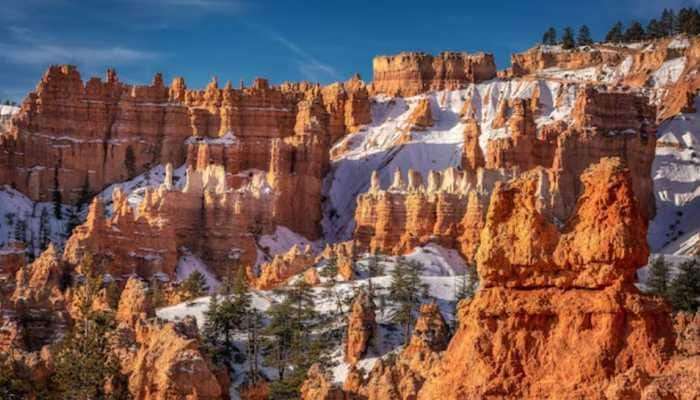INKredible India: The story of 2004 Lok Sabha election - All you need to know
The BJP-led NDA had clicked most of the right boxes during its five-year rule in India between 1999 and 2004. And yet, there was a rude shock in store once the result of Lok Sabha election 2004 was announced.
Trending Photos
) File photo
File photo In the five years since National Democratic Alliance’s win in 1999, a millennium had changed and India had kept pace with the changing dynamics of a new world order. The country, under Prime Minister Atal Bihari Vajpayee, had seen economic progress and social security. But more importantly, India had finally witnessed political stability after three elections in as many years that had threatened to cause voter fatigue and plunge the country into a political kaleidoscope of regional tugs and shoves. Much of NDA’s success in the years between 1999 and 2004 can be attributed to the faith and admiration people in the country had in Vajpayee as a leader while also opting to give the BJP-led alliance a chance to carry India forward in the aftermath of strong international statements courtesy the Pokhran II nuclear test and the triumph in the Kargil War against Pakistan in early 1998 and early 1999, respectively. These two factors had played a significant role in bringing NDA to power in Lok Sabha election 1999 but another crucial part was played by BJP’s emphasis to stitch together a formidable and cohesive alliance with regional/smaller parties under the NDA banner. Many in the country began looking beyond BJP’s Hindutva credentials and saw the party as a leader of change and of development for the whole.

At around the same time, Congress appeared a party fatigued, rather rickety and marred by internal strife as well as unsteady leadership. Sonia Gandhi had stamped her dominance within the party but it not so much in the minds and hearts of the Indian voters. Its past was in the past and the future appeared clouded in doubt, at least on its own. Little wonder then that the need for coming up with a viable alternative to the NDA was not going to be answered by this party on its own merit, strength or credential. Thus was born the United Progressive Alliance, shortly after the 2004 Lok Sabha election.
Before the election though, there was no real third front on the Indian political horizon that could have really posed a threat to the BJP, Congress and their respective alliances. Regional players were dominant in their own respective regions but those among them who had not sided with one of the two national political forces were rather insignificant in having a more national say.
Years between 1999 and 2004
As mentioned previously, the five years between the 13th and the 14th Lok Sabha election were a period of political stability and of economic progress. Vajpayee, after finally having cemented his place in the PM’s office, was able to give an affirmative direction to the country’s domestic policies and international posturing.
Some of the significant domestic measures in the country in those years included disinvestment of a number of Public Sector Undertakings (PSUs), the passing of Fiscal Responsibility Act, starting of an ambitious highway project – Golden Quadrilateral – to connect major cities of the country, opening of the telecom sector, impetus to the education sector and a general push for economic development. That all of these happened even the face of challenges galore – there were two cyclones, an oil crisis and a drought – made the statement of intent even bolder.
These five years were also a precarious time in the international community. India-Pakistan relations were nervy in the aftermath of Kargil conflict but Vajpayee prioritised peace above all else. While national security remained paramount, India acted in a responsible manner despite threats from terrorism. The 9/11 attacks in New York in 2001 was a turning point for countries around the world and the US came out in a more aggressive manner against Al Qaeda that would have deep effects on – among others – global trade and economy. India condemned the attack in unequivocal terms and recognised that it too remains vigilant in dealing with the menace of terror.
Not all may have been hunky dory as NDA assumed when they came up with the ‘India Shining’ slogan for their campaign in Lok Sabha election 2004. In hindsight, analysts pointed out several factors that may have been overlooked and/or underestimated by the ruling class. The would be elaborated upon below.
Election 2004 – Status of States:
The Lok Sabha election 2004 was conducted across 35 states and union territories in India. Three more states – Jharkhand from Bihar, Uttaranchal (now called Uttarakhand) from Himachal Pradesh and Chhattisgarh from Madhya Pradesh – had been formed as separate states in 2000.
The state and union territories which saw voting in 2004 Lok Sabha election were:
Andhra Pradesh
Assam
Arunachal Pradesh
Bihar
Goa
Gujarat
Haryana
Himachal Pradesh
Jammu and Kashmir
Karnataka
Kerala
Madhya Pradesh
Maharashtra
Manipur
Meghalaya
Mizoram
Nagaland
Orissa
Punjab
Rajasthan
Sikkim
Tamil Nadu
Tripura
Uttar Pradesh
West Bengal
Andaman and Nicobar Islands
Chandigarh
Chhattisgarh
Jharkhand
Uttaranchal
Dadra and Nagar Haveli
Daman and Diu
National Capital Territory of Delhi
Lakshadweep
Pondicherry
Political parties in the fray:
There were seven national parties and another 35 state parties which contested the Lok Sabha 2004 election, apart from many other registered (unrecognised) parties. These were:
National Parties:
Bharatiya Janata Party
Bahujan Samaj Party
Communist Party of India
Communist Party of India (Marxist)
Indian National Congress
State Parties:
Arunachal Congress
All India Anna Dravida Munnetra Kazhagam
Asom Gana Parishad
All India Forward Bloc
All India Trinamool Congress
Biju Janata Dal
Communist Party of India (Marxist-Leninist) (Liberation)
Dravida Munnetra Kazhagam
Federal Party of Manipur
Indian National Lok Dal
Janata Dal (Secular)
Janata Dal (United)
Jammu and Kashmir National Conference
Jammu and Kashmir National Panthers Party
Jammu and Kashmir Peoples Democratic Party
Jharkhand Mukti Morcha
Kerala Congress
Kerala Congress (M)
Maharashtrawadi Gomantak
Marumalarchi Dravida Munnetra Kazhagam
Mizo National Front
Manipur Peoples Party
Muslim League Kerala State Committee
Nagaland Peoples Front
Pattali Makkal Katchi
Rashtriya Janata Dal
Rashtriya Lok Dal
Revolutionary Socialist Party
Shiromani Akali Dal
Shiromani Akali Dal (Simranjit Singh Mann)
Sikkim Democratic Front
Shivsena
Samajwadi Party
Telugu Desam
United Goans Democratic Party
Uttarakhand Kranti Dal
Indian National Lok Dal
Election 2004
Lok Sabha election 2004 was held in four phases between April 20 and May 10. The election was called after PM Vajpayee recommended an early dissolution of the 13th Lok Sabha. This would turn out to be a catastrophic miscalculation by the BJP and Vajpayee although at the time, it was regarded by them as a power move bolstered by the confidence brought in by triumphs in three recent state assembly elections – Rajasthan, Madhya Pradesh, Chhattisgarh. The results to these state elections were seen within BJP as people’s stamp of approval for the BJP. The economy had been growing, the governance was stable and it was largely felt that India was shining.
India Shining, therefore, became the slogan and the battle cry for the BJP going into Lok Sabha election 2004. While NDA put Vajpayee at the centre of its campaigning, LK Advani too began his Bharat Uday Yatra which would cover 8,500 kilometres in 33 days.

In its manifesto, NDA spared no effort to highlight the work done by the Vajpayee government in a bid to strengthen its bond with its assured voter base and reach out to others. Vajpayee too was projected as a leader pivotal for India’s future.
“The NDA had promised to end political instability created by the Congress party’s dangerous destabilizing tactics. We have done so by giving India a stable and purposive government under an able leader. Adhering to the canons of ‘Coalition Dharma’ mutual trust, regular consultation, consensus building, and acceptance of a common approach, the NDA has shown how a coalition can work unitedly to fulfil the people’s aspirations.”
The manifesto also touched upon peace on the border with Pakistan, a GDP growth rate of 8 per cent, forex reserves in excess of $110 billion, housing boom and rural development as some of its achievements in the past five years.
It then outlined its seven-pronged strategy to carry India forward in the next five years:
1. India as the food factory of the world
2. India as the global manufacturing hub
3. India as the service provider to the world
4. India as the centre of the knowledge economy
5. India as the global tourism destination
6. India as the global healthcare destination.
7. India as the global higher education destination
The matter of Ayodhya temple also made a comeback.
“The NDA believes that an early and amicable resolution of the Ayodhya issue will strengthen national integration. We continue to hold that the judiciary’s verdict in this matter should be accepted by all. At the same time, efforts should be intensified for dialogue and a negotiated settlement in an atmosphere of mutual trust and goodwill.”
The odds appeared stacked against Congress. The party had had to face defeats in key states in the heartlands of India and where it was still in power, it was predicted that an anti-incumbency wave would act against it. It was also regarded that Congress was finding it extremely difficult to remain in touch with its voter base among the youth and those in rural parts of the country. Its strength in the north-eastern parts of the country too appeared to be wobbly. And against Vajpayee, Sonia hardly looked as a credible and able challenger. The Congress manifesto, nonetheless, made bold claims while also targeting NDA over unemployment and social inequality. The party assured an inclusive growth, a transparent government, re-checking certain governmental decisions taken in the last five years – disinvestment taking a prime spot in this. To possibly counter the charge of Sonia’s foreign origins – also mentioned indirectly in the BJP manifesto, Congress brought in Rahul Gandhi who would make a successful electoral debut.
Other parties, those not under the NDA umbrella and not aligned with Congress either, also tried to reach out to voters with visions and promises galore.
The campaign for the election was long drawn and one which saw leaders criss-cross the length and breadth of the country. Vajpayee and Sonia led the rallies on behalf of their respective parties and attempted to reach out to as many voters in as many regions as possible.
The Election Commission of India too got busy once again with the arduous task of conducting election in the 543 parliamentary constituencies. This was to be the first all-electronic election in the country.
The election was eventually held across 6,87,402 polling stations in the country with 5,435 candidates testing their political fortunes. Over 67 million people were eligible to cast their vote and the eventual poll percentage figure was 58.07%.
The outcome of the election was quite the shocker for the BJP. The party, despite being confident of an easy triumph came out a cropper by winning just 138 seats on its own merit. This was a decline of 44 seats. NDA had fallen short of the majority mark by quite a distance, scraping wins in just 181 seats, a decline of 89. Even some of its key allies failed to impress.
Congress, on the other hand, had managed to win 145 seats, up by 31 seats from five years ago. It was by no means a show of outstanding electoral performance – especially not when compared to performances under Jawaharlal Nehru, Indira Gandhi and Rajiv Gandhi. But what Congress did right was to join hands with other political parties and establish the United Progressive Alliance soon after the election. The UPA had a combined tally of 218 seats which may have been more than the NDA tally but still short of the majority mark.

Here, it is important to note that both Congress and the BJP had received almost as many votes as the parties had received in the 1999 election. Translating votes to seats, however, another ball game which benefited Congress rather than BJP in 2004. Around 10.3 crore voters for Congress had won the party 114 seats in 1999 but around 10.3 voters again in 2004 won it 145 seats. In contrast, 8.6 crore voters had won BJP 182 seats in 1999 but around the same number could only get it 138 seats in 2004.
| HOW BHARATIYA JANATA PARTY FARED | HOW CONGRESS FARED | ||
|---|---|---|---|
| ANDHRA PRADESH | 7 | ANDHRA PRADESH | 5 |
| ASSAM | 2 | ARUNACHAL PRADESH | 2 |
| BIHAR | 23 | ASSAM | 10 |
| GOA | 2 | BIHAR | 4 |
| GUJARAT | 20 | GUJARAT | 6 |
| HARYANA | 5 | KARNATAKA | 18 |
| HIMACHAL PRADESH | 3 | KERALA | 8 |
| JAMMU & KASHMIR | 2 | MADHYA PRADESH | 11 |
| KARNATAKA | 7 | MAHARASHTRA | 10 |
| MADHYA PRADESH | 29 | MEGHALAYA | 1 |
| MAHARASHTRA | 13 | NAGALAND | 1 |
| ORISSA | 9 | ORISSA | 2 |
| PUNJAB | 1 | PUNJAB | 8 |
| RAJASTHAN | 16 | RAJASTHAN | 9 |
| TAMIL NADU | 4 | TAMIL NADU | 2 |
| UTTAR PRADESH | 29 | UTTAR PRADESH | 10 |
| WEST BENGAL | 2 | WEST BENGAL | 3 |
| ANDAMAN & NICOBAR ISLANDS | 1 | CHANDIGARH | 1 |
| NATIONAL CAPITAL TERRITORYOF DELHI | 7 | DAMAN & DIU | 1 |
| LAKSHADWEEP | 1 | ||
| PONDICHERRY | 1 | ||
| TOTAL | 182 | 114 | |
What eventually tipped the scales in the favour of UPA was the outside support of the Left Front consisting of Communist Party of India, the CPI-Marxist, the Revolutionary Socialist Party, and the All-India Forward Bloc which together had 59 seats to offer. With the help of Independents and the outside support of Bahujan Samaj Party (19 seats), Samajwadi Party (36 seats) and Kerala Congress (1 seat), UPA hit the magic mark of 335 to stake claim to form the government.
Jubilant with the result and the post-result political reaching, Congress and the entire country was set to welcome Sonia Gandhi as the new PM. But in a surprise move, she declined the post on May 18. "The post of prime minister has not been my aim. I was always certain that, if ever I found myself in the position I am in today, I would follow my inner voice. I humbly decline the post,” she told her party.
Critics of the Congress party continue to maintain till date that this was a strategic move on Sonia’s part to keep the PM’s chair warm for Rahul once he had acquired enough political experience and acumen. The eventual choice for the post in Manmohan Singh was also a masterstroke because, it is alleged, Sonia would be able to call the shots from behind the scene while having a non-controversial figure as the face of the government.
BJP, nonetheless, was left licking its wounds.
The party’s loss has been extensively analysed in the years after 14th Lok Sabha election. It is believed that the party had paid the price for being overconfident, of having benefited the middle-class through its economic policies rather than the urban and rural poor who vote in bulk, was punished for over-emphasising on ‘India Shining’ and for an over-extended campaign period it just could not sustain in terms of momentum.
New York Times had this to say in a report published on May 13 of 2004:
“The B.J.P. had constructed an American-style presidential campaign around Mr. Vajpayee's perceived popularity, but it ran aground on the realities of the Indian parliamentary system, in which voters turned on incumbent legislators who they felt had delivered little. Voters - particularly, but not exclusively, in rural areas - rebelled against the idea of "India Shining" that had been peddled by the incumbent government in a glossy, costly public relations campaign.”
The writing was on the wall, whatever be the reason for the win and defeat. Congress had returned to power after a gap of more than a decade and India looked set for five years under a PM who had played a key role in the economic restructuring of the country in the early 90s.
Stay informed on all the latest news, real-time breaking news updates, and follow all the important headlines in india news and world News on Zee News.
Live Tv







)
)
)
)
)
)
)
)
)
)
